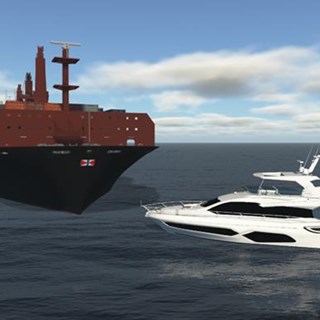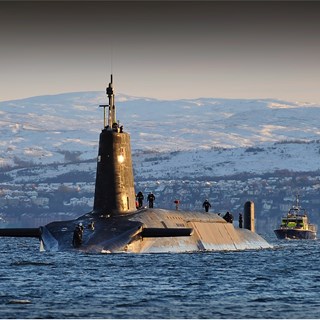As part of a series of articles on Climate and Defence, BMT is taking a closer look to see how defence agencies and military forces are approaching and addressing climate change risks and opportunities. This third article examines the situation in the United Kingdom (UK).
The recently released UK Ministry of Defence (MOD) document, Climate Change and Sustainability Strategic Approach (March 2021), have two excellent forewords to encapsulate the ‘why’ of Defence and Climate.
On decarbonisation, Minister Jeremy Quin, Minister for Defence Procurement, notes:
Alongside recognising the reality of change, we are determined to play our full part in helping the government address climate change head on and achieve our legal commitment of net zero by 2050. Inevitably, the very scale of what Defence is called upon to do, makes us a carbon emitter. However, we recognise both the necessity and opportunity to build on our existing successes in cutting carbon and mitigating Defence’s impact on the environment.
On resilience and adaptation, Lt Gen. Richard Nugee, Climate Change and Sustainability Review Lead in Defence, notes:
Now firmly a Defence problem, climate change is a significant challenge. Without adequate assessment of its effects, we leave ourselves exposed. We cannot let our capabilities become less effective against vulnerabilities we cannot see clearly. We have to afford to keep up with the pace of change.
The document also acknowledges the global leadership that UK Defence Forces will need to respond to the emerging geopolitical and conflict-related threats exacerbated by climate change. Notably, it is recognised that climate events (both acute and chronic) will worsen poverty and gender inequality and create instability that threatens peace.
Strategic Ambition for 2050
In taking these sentiments forward, the Strategic Approach document sets out a strategic ambition for 2050 across these three themes: (i) decarbonisation, (ii) resilience and (iii) strategic leadership, underpinned by a set of guiding principles and the methods needed to meet the challenge.
Implementation of the Strategic Approach is set to occur in ‘epochs’ summarised from the document as follows (page 20 of the Strategic Approach document):
Epoch one – setting the foundations - 2021-2025: Defence will deliver a step change in the already planned projects; initially, most of these will be opportunities on the estate. The first epoch will include working with suppliers to identify ways to reduce emissions in the supply chain through the equipment and contract conditions we set. We will create the skills base to apportion carbon targets better and develop a fuller cross Departmental understanding of sustainability in the broadest sense. A comprehensive baseline and database will be built to allow decisions on a detailed plan for all themes in epochs two and three. Carbon targets and broader sustainability and GGC targets will run through the yearly Defence Plans. These will be disaggregated across defence organisations.
Epoch two - minimising and fitting for the future – 2026-2035: Building on the successes from epoch one, in the subsequent years, the defence will look to reduce emissions significantly using existing and emerging technology, maximise the opportunity to enhance the global response to the threat that climate change poses to current and future operational capability and build further resilience into the estate, supply chain and future equipment. The defence should commit exploitation, development and innovation funding through the Defence/Spending Review to determine how to use emerging technologies for its benefit.
Epoch three - harnessing the future - 2036-2050: In the final 15-year period, the defence must do everything possible to harness novel technologies that further build resilience and reduce emissions. Efficiency and operational effectiveness will depend on the innovation and foresight of previous epochs. We will deliver on any successor to the UN Sustainable Development Goals.
Initial Action Plan
In framing its activities in Epoch 1, the Strategic Approach document includes an initial action plan of near-term actions representing the ‘foundation stones’ needed for the defence’s journey.
These include actions that are targeted for achievement by 2025 (the end of Epoch 1) and are related to:
- Sustainable culture and behaviour
- Governance and head office
- The built estate
- The rural estate
- Climate, security and international
- Operational capability
- Support, maintenance and logistics
- Procurement and industry
- Commercial
- Finance
- Data
- Research and Development
An impressive total of 37 sub-actions are articulated under these headings, with most work to commence in the 1st year of implementation.
To this end, it is understood that the MOD is already taking action to create a group to cohere and steer the Front Line Commands’ response on climate and sustainability. Tangible action has also commenced through the Defence Equipment & Support Environmental Strategy (released Dec 2021). Industry engagement is active, as seen in the Measuring Greenhouse Gas Emissions in the Defence Sector as promoted by ADS, but significant work lies ahead.
In its totality, the Strategic Approach provides a robust framework (not unlike an ESG framework) for understanding and dealing with climate change. Unlike many other strategy documents, it moves beyond the high-level principles into articulating the ‘near-term’ 2025 actions, clearly showing the areas the defence intends to act on and prioritising its response to the three-theme climate challenge.
Notably, the Strategic Approach acknowledges the opportunity of climate change – Defence ‘will be stronger if it keeps up with new, adaptable and efficient options. Done right, this will improve how it meets the future defence and security challenges but also represents a cultural and functional model for other Defence agencies and Defence forces moving forward.








